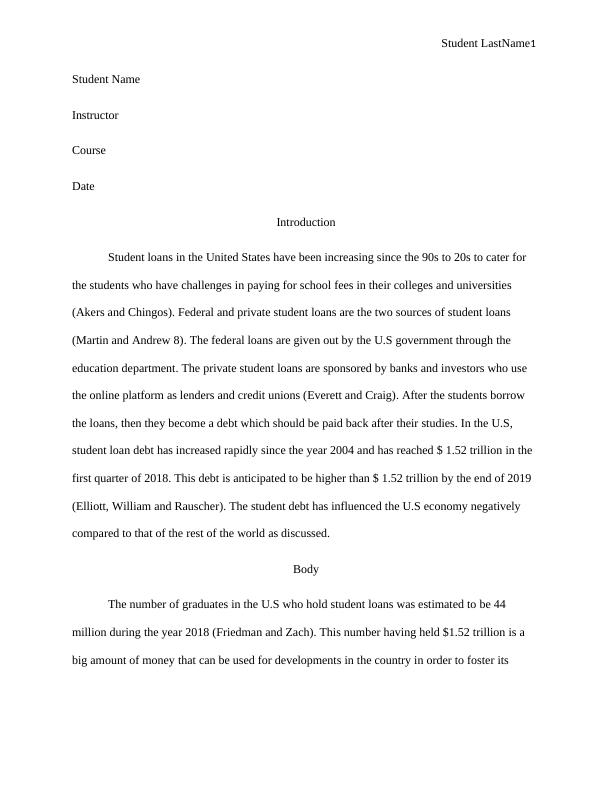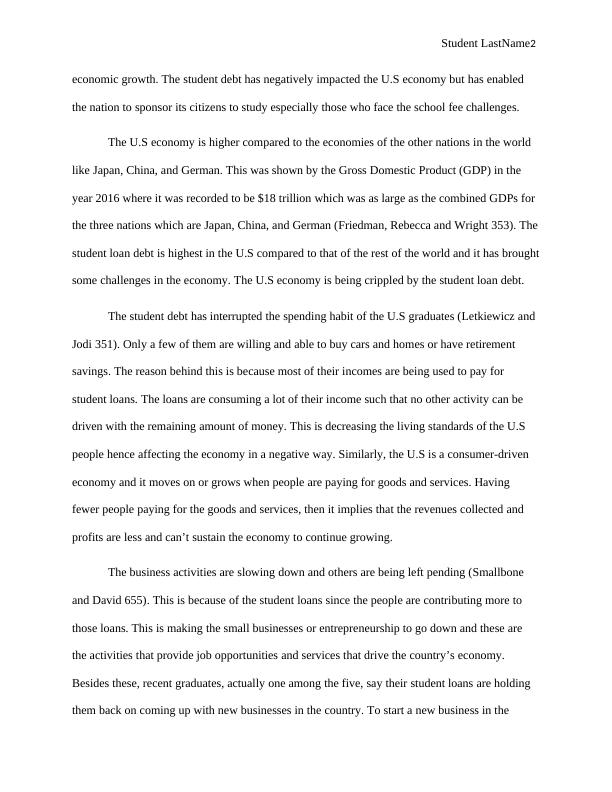Impact of Student Loans on the U.S Economy
Added on 2023-01-23
7 Pages1957 Words54 Views
Student LastName1
Student Name
Instructor
Course
Date
Introduction
Student loans in the United States have been increasing since the 90s to 20s to cater for
the students who have challenges in paying for school fees in their colleges and universities
(Akers and Chingos). Federal and private student loans are the two sources of student loans
(Martin and Andrew 8). The federal loans are given out by the U.S government through the
education department. The private student loans are sponsored by banks and investors who use
the online platform as lenders and credit unions (Everett and Craig). After the students borrow
the loans, then they become a debt which should be paid back after their studies. In the U.S,
student loan debt has increased rapidly since the year 2004 and has reached $ 1.52 trillion in the
first quarter of 2018. This debt is anticipated to be higher than $ 1.52 trillion by the end of 2019
(Elliott, William and Rauscher). The student debt has influenced the U.S economy negatively
compared to that of the rest of the world as discussed.
Body
The number of graduates in the U.S who hold student loans was estimated to be 44
million during the year 2018 (Friedman and Zach). This number having held $1.52 trillion is a
big amount of money that can be used for developments in the country in order to foster its
Student Name
Instructor
Course
Date
Introduction
Student loans in the United States have been increasing since the 90s to 20s to cater for
the students who have challenges in paying for school fees in their colleges and universities
(Akers and Chingos). Federal and private student loans are the two sources of student loans
(Martin and Andrew 8). The federal loans are given out by the U.S government through the
education department. The private student loans are sponsored by banks and investors who use
the online platform as lenders and credit unions (Everett and Craig). After the students borrow
the loans, then they become a debt which should be paid back after their studies. In the U.S,
student loan debt has increased rapidly since the year 2004 and has reached $ 1.52 trillion in the
first quarter of 2018. This debt is anticipated to be higher than $ 1.52 trillion by the end of 2019
(Elliott, William and Rauscher). The student debt has influenced the U.S economy negatively
compared to that of the rest of the world as discussed.
Body
The number of graduates in the U.S who hold student loans was estimated to be 44
million during the year 2018 (Friedman and Zach). This number having held $1.52 trillion is a
big amount of money that can be used for developments in the country in order to foster its

Student LastName2
economic growth. The student debt has negatively impacted the U.S economy but has enabled
the nation to sponsor its citizens to study especially those who face the school fee challenges.
The U.S economy is higher compared to the economies of the other nations in the world
like Japan, China, and German. This was shown by the Gross Domestic Product (GDP) in the
year 2016 where it was recorded to be $18 trillion which was as large as the combined GDPs for
the three nations which are Japan, China, and German (Friedman, Rebecca and Wright 353). The
student loan debt is highest in the U.S compared to that of the rest of the world and it has brought
some challenges in the economy. The U.S economy is being crippled by the student loan debt.
The student debt has interrupted the spending habit of the U.S graduates (Letkiewicz and
Jodi 351). Only a few of them are willing and able to buy cars and homes or have retirement
savings. The reason behind this is because most of their incomes are being used to pay for
student loans. The loans are consuming a lot of their income such that no other activity can be
driven with the remaining amount of money. This is decreasing the living standards of the U.S
people hence affecting the economy in a negative way. Similarly, the U.S is a consumer-driven
economy and it moves on or grows when people are paying for goods and services. Having
fewer people paying for the goods and services, then it implies that the revenues collected and
profits are less and can’t sustain the economy to continue growing.
The business activities are slowing down and others are being left pending (Smallbone
and David 655). This is because of the student loans since the people are contributing more to
those loans. This is making the small businesses or entrepreneurship to go down and these are
the activities that provide job opportunities and services that drive the country’s economy.
Besides these, recent graduates, actually one among the five, say their student loans are holding
them back on coming up with new businesses in the country. To start a new business in the
economic growth. The student debt has negatively impacted the U.S economy but has enabled
the nation to sponsor its citizens to study especially those who face the school fee challenges.
The U.S economy is higher compared to the economies of the other nations in the world
like Japan, China, and German. This was shown by the Gross Domestic Product (GDP) in the
year 2016 where it was recorded to be $18 trillion which was as large as the combined GDPs for
the three nations which are Japan, China, and German (Friedman, Rebecca and Wright 353). The
student loan debt is highest in the U.S compared to that of the rest of the world and it has brought
some challenges in the economy. The U.S economy is being crippled by the student loan debt.
The student debt has interrupted the spending habit of the U.S graduates (Letkiewicz and
Jodi 351). Only a few of them are willing and able to buy cars and homes or have retirement
savings. The reason behind this is because most of their incomes are being used to pay for
student loans. The loans are consuming a lot of their income such that no other activity can be
driven with the remaining amount of money. This is decreasing the living standards of the U.S
people hence affecting the economy in a negative way. Similarly, the U.S is a consumer-driven
economy and it moves on or grows when people are paying for goods and services. Having
fewer people paying for the goods and services, then it implies that the revenues collected and
profits are less and can’t sustain the economy to continue growing.
The business activities are slowing down and others are being left pending (Smallbone
and David 655). This is because of the student loans since the people are contributing more to
those loans. This is making the small businesses or entrepreneurship to go down and these are
the activities that provide job opportunities and services that drive the country’s economy.
Besides these, recent graduates, actually one among the five, say their student loans are holding
them back on coming up with new businesses in the country. To start a new business in the

Student LastName3
country needs some approvals from the government and most of the graduates are not able to get
their new business permit approval due to the debt owed by the federal government or private
lenders. Eventually, student loans get to power the U.S economy through spending and business
engines. This affects indirectly the growth and development of the economy.
These loans are slowing down the housing market in the U.S (Igan, Deniz and Kang 1).
The borrowers are being held back to pay for the loans of which they should be saving or
purchasing homes. 41% of the student borrowers have delayed as homeowners and 27% of them
have yet tried to move out of their parents’ homes with difficulties. Home buying is closely
associated with the mortgage market and having fewer people buying homes, then fewer people
are likely to borrow mortgage loans. These loans are important sources of revenue for the banks
and investment firms. If the investors can’t get enough capital to invest, then the investment in
the economy goes down.
However despite the challenges of the student loans the U.S economy is also impacted
positively by the student loans (Avery, Christopher and Turner 165). This means that, apart from
the huge student loan debts in the country, there are benefits coming from the educated people in
the nation. Majority of the students in the world look back to borrow for their education and at
the same time a positively impact the economy.“The main macroeconomic impact of student
loans, particularly over the longer run, is via the boost to output and productivity from a more
educated and skilled workforce,” the White House said in its 2016 report Investing in Higher
Education (Obama’s Report). Basing the report, student loan debt is a tool that assists more
students in America to access higher learning. The higher the learning attained, the more the
benefits to individuals and the economy.
country needs some approvals from the government and most of the graduates are not able to get
their new business permit approval due to the debt owed by the federal government or private
lenders. Eventually, student loans get to power the U.S economy through spending and business
engines. This affects indirectly the growth and development of the economy.
These loans are slowing down the housing market in the U.S (Igan, Deniz and Kang 1).
The borrowers are being held back to pay for the loans of which they should be saving or
purchasing homes. 41% of the student borrowers have delayed as homeowners and 27% of them
have yet tried to move out of their parents’ homes with difficulties. Home buying is closely
associated with the mortgage market and having fewer people buying homes, then fewer people
are likely to borrow mortgage loans. These loans are important sources of revenue for the banks
and investment firms. If the investors can’t get enough capital to invest, then the investment in
the economy goes down.
However despite the challenges of the student loans the U.S economy is also impacted
positively by the student loans (Avery, Christopher and Turner 165). This means that, apart from
the huge student loan debts in the country, there are benefits coming from the educated people in
the nation. Majority of the students in the world look back to borrow for their education and at
the same time a positively impact the economy.“The main macroeconomic impact of student
loans, particularly over the longer run, is via the boost to output and productivity from a more
educated and skilled workforce,” the White House said in its 2016 report Investing in Higher
Education (Obama’s Report). Basing the report, student loan debt is a tool that assists more
students in America to access higher learning. The higher the learning attained, the more the
benefits to individuals and the economy.

End of preview
Want to access all the pages? Upload your documents or become a member.
Related Documents
Trump’s Immigration Policies - Doclg...
|4
|746
|52
